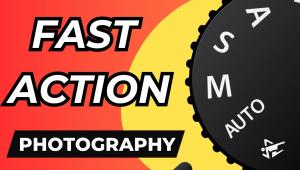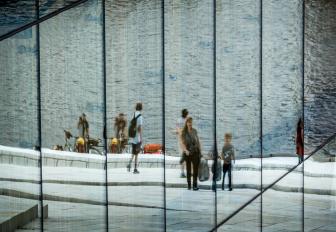Ask A Pro: Scott Kelby Answers Your Photography Questions

Hi everybody! I’m very excited to be launching a new Q&A column here in Shutterbug—a magazine I’ve been reading, and been a fan of, for so many years—so it’s truly an honor to be here with you. I invite you to send in your questions to editorial@shutterbug.com (with "For Scott Kelby" as the subject line), and I’ll do my best to answer them in Ask a Pro. OK, let’s jump right to it:
Q: I bought a pretty large softbox so I could get really soft light for portraits, and while it is pretty soft, is there a way I can get it even softer?
A: There are two things that will help; one is free and the other is only $20. The free one is to position that softbox as close as you can get it to your subject, without actually seeing it in the shot. The closer you get that light, the softer and creamier it will look (it will also be brighter, so don’t forget to turn the power down a bit). The second method costs just $20, but works wonders: buy a one-stop, collapsible diffuser (I use Westcott’s 30” Basics 1-Stop Diffusion Panel) and put it between your subject and the softbox, and you’ll be amazed at the softness that second layer of diffusion brings. Of course, adding a one-stop diffuser is going to eat up some of the power of the light, so you’ll need to increase the power of light by around one stop. If you don’t have an assistant or friend to hold the diffuser in place, they make stands with two clamps designed to hold reflectors or diffusers in place that’ll do the trick. One more thing: make sure you don’t get a reflector; it has to be a “diffuser.”
Q: What’s the first setting you change when you get a new camera?
A: The very first thing I do is change the center button on the back of my camera to be a one-click zoom so I can quickly check the sharpness of my images while I’m still at the shoot. Everything looks sharp on that tiny three-inch screen and without zooming in to check sharpness while you’re still at the shoot (and you can retake the shot), you’re just setting yourself up for heartbreak later when you open the image on your computer and find out that the shot you thought you totally nailed is soft. If checking the sharpness is just one click away (rather than three clicks to zoom in, and three to zoom back out, which is a pain), you’ll start using it more. On Canon’s DSLRs, this assignable button is called the “Setting Button” (the one in the center of the Quick Dial), and on Nikon's it’s called the Multi-Selector Center Button.
Q: If you had one piece of advice for someone wanting to take better portraits, what would it be?
A: OK, this is one-and-a-half answers, because before I give you the second part, I want you to know that I fully believe that great portraits come from getting great expressions, real emotion, and a genuine connection and engagement with your subject, so I’m going to jump past that to something else you can do technically that will make a big difference (and will clear you to focus on what I just said), and that is simply this: start worrying about the background. If you want better portraits, make sure the background is really simple. When you start worrying about how the background looks—really giving it a careful eye not to have distracting elements back there, and keeping it clean and simple—your foreground (the subject) will fall into place and the overall quality of your portraits will take a big leap forward. This is bigger than it sounds.
Q: I’ve heard somebody say that Raw images look better in Capture One Pro than they do in Lightroom or Camera Raw. Can this be true?
A: Raw images definitely look different in Capture One Pro than you’re used to seeing in Lightroom or Camera Raw. You might like their “flavor” or you might not, so I can’t say it’s better, but it’s definitely different. Lightroom and Camera Raw produce a more flat Raw image and I imagine Adobe’s engineers would tell you it’s more true to the original capture. Raw images processed in Capture One Pro look more “juiced” to me (not a bad thing; they look like they’ve had some Clarity already applied, and the colors seem warmer), but whatever they’re doing, it’s definitely their own take on interpreting the Raw data and some folks might like it better. The best way to find out is to download their free trial version; open the same images in Lightroom or Camera Raw, then open it in Capture One Pro, and do a side-by-side comparison to see which one “speaks” to you.
Q: Why would I need to get my white balance right in the camera when I can just pick the white balance I want later in Photoshop?
There are a couple of advantages to getting the color right in the camera, and one is you don’t have to fix it later in Photoshop. If the color looks right coming out of the camera, then instead of spending your time trying to fix it, you can be working on something else (like finishing off your photo). Another big advantage is that you’ll now see how the image is supposed to look while you’re doing the shoot, instead of telling yourself, “I know her skin looks blue, but I can fix that in post.” Why not see her skin looking how it’s supposed to look now? It’ll actually make looking at your images during the shoot more enjoyable. Plus, all it takes is looking up to see what lighting you’re under, and then moving one dial. Couldn’t be easier. If you look up and see trees, set your White Balance to Shade. If you look up and you see Clouds, set it to Cloudy. If you look up and start squinting from the sun, set it to Daylight, and so on. Plus, one last thing: you get respect from old guys like me who look at photography as a craft and part of that craft is getting it as close to “right” in the camera as you can. Just sayin’ ;-)
Scott Kelby is a photographer, Photoshop Guy, award-winning author of more than 50 books, and CEO of KelbyOne, an online training, education, and publishing firm that helps photographers take the kind of images they’ve always dreamed of. You can learn more about Scott at his daily blog (scottkelby.com), or follow him on Twitter: @scottkelby.
(Editor’s Note: Shutterbug is excited to launch a new Q&A column from professional photographer, writer, and educator Scott Kelby. Scott is here to answer all your photography-related questions, so if you have something you’d like to know, e-mail him at editorial@shutterbug.com with "For Scott Kelby" as the subject line, and your query could be featured in the next edition of Ask a Pro.)
















































